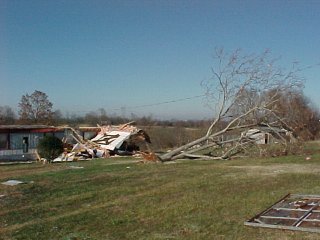Early on December 16, 2000, forecasters were trying to determine the impact an approaching cold front would have on Middle Tennessee's weather. Two particular areas of concern mentioned in the Warning & Forecast Office (WFO) Nashville's Area Forecast Discussion from 3:25 a.m. (CST) included the potential for heavy rain and flash flooding, and a slight risk of severe thunderstorms. The atmospheric wind profile over the area at that time was unidirectional, but strong. Winds at 2,000 feet were an impressive 50 knots. By 9:30 a.m., forecasters at Nashville were forecasting the "best potential for severe weather" during the afternoon to be south of middle Tennessee, over Alabama and Mississippi, in vicinity of a mid-level dry slot rounding base of a trough over the Mississippi River Valley. However, it was also stated that "this severe weather could potentially threaten some of our southern counties late today and this evening."
At 10:00 a.m., the Storm Prediction Center issued a tornado watch for western, central, and northern Alabama and eastern Mississippi, effective until 4:00 p.m. that afternoon. This watch area came to the Tennessee line, putting extreme southern middle Tennessee on notice for the potential for severe weather as well. The specific area was 95 statute miles east and west of a line extending from 65 miles southeast of Laurel, MS to 25 miles northeast of Muscle Shoals, AL. Again, the impact of a speed maximum over central Texas moving eastward into the area during the day was highlighted, along with expectations of "deep layer shear, on the order of 55 knots."
As expected, the greatest magnitude of severe weather on December 16 occurred south of Tennessee, including a deadly and unusually strong cold season tornado at Tuscaloosa, AL. The tornado that moved out of northern Alabama into southern middle Tennessee early in the afternoon was weakening rapidly. However, damage did occur in Limestone County, AL before the tornado moved into Lincoln County, TN. (See picture below of the tornado moving across Wheeler Lake, AL.) Warnings issued by the Birmingham WFO and numerous ham/spotter reports gave outstanding ground truth to the radar images. The Lawrence County, TN Skywarn Spotters relayed several reports of the tornado being on the ground. The Middle Tennessee Skywarn Net provided outstanding spotter reports. The Doppler radar in northeast Alabama provided excellent coverage of this storm while in Limestone County, and the WFO in Birmingham significantly aided in the warning process when they called Nashville to report a "confirmed tornado on the ground," headed toward southern middle Tennessee.

A tornado warning was issued for southeastern Giles County and western Lincoln County, in southern middle Tennessee, at 12:42 p.m., while the tornado was still 15 to 20 minutes away. A call was placed to the Lincoln County sheriff's office at the same time to alert them that a confirmed tornado would be crossing over Interstate 65, near Ardmore, shortly. In addition, the communities of Dell Rose, Elkton, and Cash Point were mentioned in the text of the tornado warning as being in the path of the storm.
Damage was reported just into Lincoln County north of Cash Point and State Highway 110 at approximately 1:05 p.m. Warning lead time for this tornado was close to 25 minutes. A small mobile home was damaged extensively near the initial touchdown location. (See picture below.)

Other roof damage occurred within a quarter mile of the mobile home. A few trees were uprooted near the mobile home. The tornado appeared to lift and move to the northeast just over one mile. Some tree damage occurred over that mile but seemed to be only in the crowns of the trees. At the one mile mark a small outbuilding was destroyed along with several large limbs broken out of trees. The tornado skipped over an elementary school (location of a warning siren), and then caused more roof damage.
The tornado tore several shingles off a fairly new house. Just over a tenth of a mile further, the tornado picked up the roof of a cinder block garage and turned it approximately 90 degrees before setting it back down. (See picture below.)

No damage was encountered after the garage.
No personal injuries were reported with this storm system.
Total storm track was less than 2 miles.
Sincere appreciation goes to the Lincoln County Emergency Management Agency for their help during the storm survey, and for the time taken to discuss severe weather preparedness with us. Lincoln County EMA has put together a superior warning system in their county, which includes a "response network," comprised of local facilities, such as churches and fire houses, which open their doors as storm shelters for area residents whenever severe weather warnings are issued.
Darrell Massie
Lead Forecaster
Ralph Troutman
Data Acquisition and Program Manager